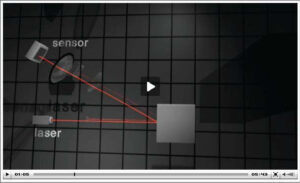by Todd Schuett, Creative Technology Corporation
Video can distinguish your company from the competition. In today’s global economy, video can help you tell your story, your way.
When my former company introduced high-speed CNC milling controls in 1993, we quickly learned that it was hard to sell “high speed” with pictures and brochures. Video provided a solution that allowed us to show the speed of the new milling controls, compare performance side-by-side and show rare or difficult setups on-demand. Video helped us differentiate ourselves.
Video can help you stand out in a crowd. If personal service is your company’s trademark, introduce employees to your audience. If you have an innovative process, show it and help your audience understand that you offer exactly what they need. If you find that you always get the order once the prospect steps inside your facility, don’t wait – take the facility to them! Video can convey a message in a way that no other medium can communicate.

Video from Concept to Reality
So, how do you charge up your marketing by taking video from concept to reality? A good video starts with a good plan. What do you want to tell people who might need your company’s product or service? Have you put together a plan of what you would tell each customer and prospect given the opportunity? Planning the “perfect” two or three minute sales presentation is the most important step to creating a good video.
“Three minutes,” you ask? “That’s way too little time to tell all we need to share about our amazing company!” I’d quickly answer, “No, it isn’t.” Telling your story quickly and emphasizing the key points is the key to a good video. If your story becomes dull for even a second, viewers may wander. The idea is to make a video that is interesting and informative enough – and brief enough – that every viewer watches from start to finish, allowing you to tell the whole story.
Creating a succinct message may seem like a big challenge, but it’s a marketing concept that is pivotal to your success. Marketing isn’t like a sales visit, where an audience might be captive to your message for 15 minutes or more. Marketing is an opportunity to sell your company in an on-demand world. Your client or prospect reads or watches when he wants, and he can cut you off by turning the page or going to another video as soon as he loses interest. Understanding this and keeping your message interesting and to the point is fundamental to your success.

Crafting a Message
So, what do you want to tell the prospective customer? Start with one of your customers! Find out what they like about your company, and why they choose to work with you. In fact, don’t ask just one – different clients may deal with you for a variety of reasons. Try to learn all you can to refine your message.
Learning more about your company from your customers can be a revelation, too. You may be surprised to know that one client doesn’t know about some of the offerings that others take for granted. This makes another important point: make the message universally appealing to everyone. Your best and most important prospects may already be your best customers. This doesn’t mean you should stop marketing to them; but rather, if they’re already dealing with you, it’s important to continually reinforce that business and try to build from it.
Ideally, the video marketing won’t be directed simply at new prospects, but should encompass existing ones, too. In fact, go beyond that and assert that everyone should watch your video. You want the video to be informative and interesting enough to anyone even casually associated with or potentially associated with your company so that they will watch it and learn more.
Remember that video is a multi-media experience. That means that there is more than one channel of communication with the viewer. The moving picture isn’t the only opportunity you have to communicate. Sound can be used. Images can be combined. The video can skip past boring parts of a process to show the beginning and end. Media can be combined, and voiceovers can be used while other processes are visually promoted onscreen. A mood can be created with background music. Combining media opportunities is part of the craft and helps convey more information in less time.
Now, it’s time to shape the message. Consider the following suggestions for potential content:
- Capabilities
- Facilities tour
- Introduce key people
- Success stories
- Legacy, history of company
- Industry participation
- Details of a unique process
Prioritize what’s important to your company. The whole story doesn’t need to be told. Instead, tell enough to make the prospect open the door for a salesperson. Don’t lose sight of the limitation that a video will be consistent, for better or for worse. Your video can’t tell a different story for each prospect; yet at some point, they need information on how you can specifically help them. That’s where the salesperson comes in. If your marketing video does its job right, the door is opened for the salesperson, and the road to success is smoother.

Telling the Story
Once the topics are prioritized, it’s time to figure out the most effective way to tell the story. Do you want to go onscreen and tell the story yourself? Is there anyone else you want to feature onscreen? Do you want to tell your story with your own voice, or do you want a professional narrator? Professional narration can be a great option. Words can have more meaning when spoken with strong inflections. Professional voice talent understands how to enunciate for maximum impact. On the other hand, professional voiceover may sacrifice an opportunity to personalize your company. Narration by you or key staff can introduce your company in a way that makes you real, helping prospects see you as a company of people, not just a company. Each option has its advantages, so choose what will work best for you.
Next, decide what to show your audience. That may not be the same as determining the message. Much like the evening news starts with an anchor telling a story with words, the message is stronger when imagery is shown to support the story, even while the anchor is speaking. Imagine a video talking about your company’s stunning customer service. Rather than focusing on the person speaking, the video would be more interesting if it quickly showed five-second clips of an employee on phone support, a worker in the factory or warehouse repairing product, another staff member pulling a customer order and shipping the product, or perhaps even the truck leaving the building with finished product. A glimpse of a next-day air sticker can allow the viewer to infer fast service without ever hearing those words in the script. With multimedia, a lot of information can be conveyed in very little time.
If your company’s product is custom and technical, you may want to assert technical capability and superiority in the video. Show product in development, from design and engineering through manufacturing, showing machines and machining processes, precision inspection, quality reports and more. Showing the end-product can help viewers relate to what your company does and understand how your company impacts their life. Plastic injection moldmaking provides a great example. Your company creates the mold, but a plastic part is the end-product. Showing the mold is interesting for an engineer or a moldmaker, but also showing the final part can help your company connect with more people involved in the business transaction – the secretary, purchasing agent, buyer or bookkeeper, for example. Don’t lose sight of the fact that your business relies on many people with different responsibilities. Your video should target all departments within your prospects’ facilities.
Not all videos are created equally. Years ago, I’d tell people that the best feature of our CNC control was that it was a PC, making it simple to understand. I’d then quickly assert that its worst feature also was that it was a PC, so everyone thought they were an expert, potentially creating problems in the control. So it goes with video. Today, a good camcorder can be purchased for $1,000 or less, and anyone can shoot a video with a cell phone, as we see every day on YouTube. Will a quick home video serve your company well for marketing? Probably not. Maybe you know a college student who has made a video or two. Will that do the job? Only you can decide.
Much like you’re a professional at what you do, professional video producers are good at what they do. The experienced ones have seen the best and the worst of what can be done, and more experience helps them tell your message more effectively. Professionals use camera equipment that costs tens of thousands of dollars for a reason. Often the lighting equipment is even more expensive. Quality audio capture is specialized, too, requiring still more equipment. Like anything today, the gap is narrowing between professional and amateur, but there still is a big difference.
You might think that only you can tell your story, because you’re the only one who knows it. Wrong! Outside input can be very helpful to cull the important content from the useless or negative content. A professional with industry experience can help differentiate your company from the competition.
Marketing is about differentiating yourself. Video can do that, and a professional can help.
Todd Schuett has worked with machinery and tooling since 1974, first in the shop and then selling the equipment. His background includes sales and marketing, applications engineering, teaching CNC programming and tooling techniques, and developing and selling computer applications and networking for manufacturing. Today, as the president of Creative Technology Corporation, Schuett is an enthusiastic advocate for American manufacturing, focusing entirely on marketing for manufacturers through photography, video, web site development and writing. For more information, visit www.creat.com.





